Endpoint security is an essential consideration for any IT team. With employees accessing sensitive company data from various devices, ensuring robust security measures is paramount to safeguarding against cyber threats.
Here are eight crucial tips for employees to enhance endpoint security:
1. Use Passwordless Authentication:
By using passwordless authentication methods, an employee can have their identity verified without requiring them to provide a password. Instead of a password, users can authenticate themselves using other factors, such as biometric data (e.g., fingerprints or facial recognition), possession of a physical device (e.g., a smart card or smartphone), or a one-time code sent to their email or phone.
The result is heightened security. Passwords are vulnerable to a variety of attacks, such as phishing, credential stuffing, brute force attacks and password spraying. By eliminating the need for passwords, passwordless authentication can help protect against these attacks and enhance the security of your accounts and systems.
2. Enable Device Encryption:
Enable full-disk encryption on all company-issued devices and encourage employees to do the same for their personal devices. Encryption scrambles data stored on the device, making it unreadable to unauthorized users even if the device is lost or stolen. This adds an extra layer of protection, especially for sensitive company information stored locally.
3. Keep Software Updated:
Software updates often include patches for known vulnerabilities, which cybercriminals can exploit to infiltrate devices. Enabling automatic over-the-air updates wherever possible can ensure devices are always equipped with the latest security features and fixes.
4. Implement Endpoint Protection Software:
Deploy reputable endpoint protection software on all devices to detect and block malware, ransomware, and other malicious threats. These security solutions provide real-time protection by scanning files and monitoring device activity for suspicious behavior. Ensure that endpoint protection software is configured to automatically update and perform regular scans for optimal security.
5. Use Zero Trust, Cloud-Based Resources Rather than VPNs:
Some still tout the security of the VPN, but the reality is that they are more than vulnerable. Once breach you may recall in recent history that stemmed from a compromised VPN was the Colonial Pipeline hack in 2021, which resulted in a massive sum paid in ransom to bad actors.
One of the main challenges to VPNs is ease of access. Once a successful VPN connection has been established, whoever is using that connection has the ability to access the entire domain internally. The only thing standing in the way are credentials, like a username and password, of a privileged (administrator) account. Once the credentials are cracked, the user (whether wanted or not) is then able to move laterally throughout an environment – accessing everything.
Fortunately, VPNs are no longer necessary for groups embracing a cloud-based Zero Trust infrastructure. This cutting-edge approach renders the traditional “Castle and Moat” strategy obsolete by granting employees access to resources from any location and device. Utilizing a cloud-based system accelerates workflows, fosters collaboration, and boasts user-friendliness, offering a secure connection for both users and devices. It is ultimately a far more secure solution to using VPNs.
6. Practice Safe Browsing Habits:
Educate employees about the dangers of clicking on suspicious links, downloading attachments from unknown sources, and visiting untrustworthy websites. Emphasize the importance of exercising caution when browsing the internet and encourage the use of ad-blockers and script-blockers to mitigate the risk of encountering malicious content.
7. Enable Firewall Protection:
Ensure that firewalls are enabled on all devices to monitor and control incoming and outgoing network traffic. Firewalls act as a barrier between the device and the internet, blocking unauthorized access and preventing malicious software from communicating with external servers. Configure firewalls to restrict traffic to necessary ports and protocols, reducing the attack surface for cyber threats.
8. Educate Employees on Security Best Practices:
Provide regular cybersecurity awareness training to educate employees on security best practices and the latest threats. Cover topics such as phishing awareness, social engineering tactics, password hygiene, and data protection measures. Encourage employees to report any suspicious activity or security incidents promptly to the IT department.
Conclusion:
By following these eight tips for endpoint security, employees can play a crucial role in safeguarding company data and devices from cyber threats. By fostering a culture of security awareness and providing employees with the necessary tools and knowledge, groups can significantly reduce the risk of endpoint-related security breaches and ensure a more secure digital environment.
Download the Six Pillars of Modern Endpoint Management
Deep Dive Concepts such as:
- Zero Trust
- Passwordless Authentication
- Zero Touch Provisioning
- App Management
- Over-The-Air Updates
- Remote Support






